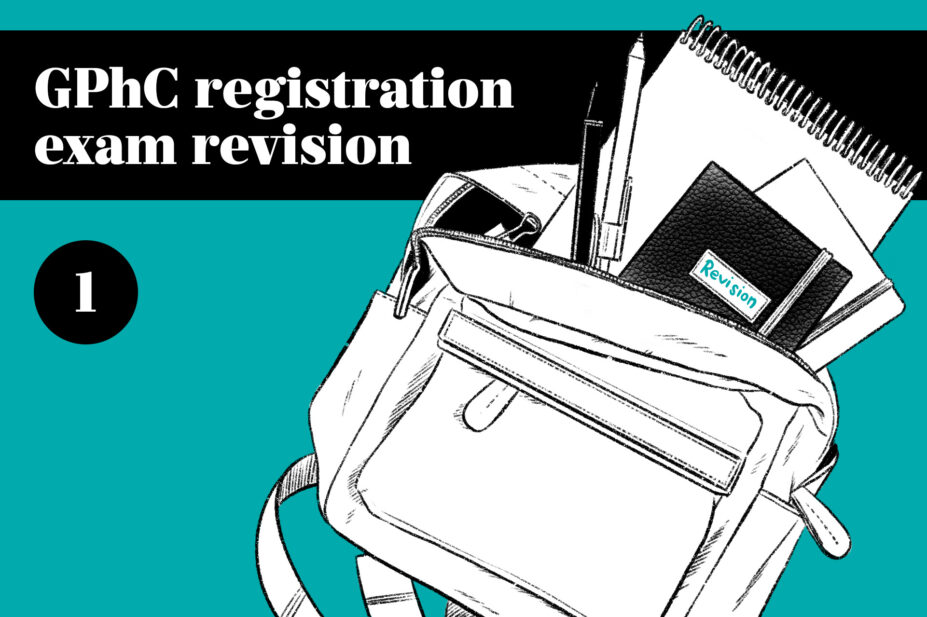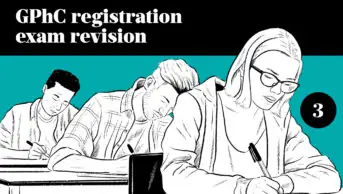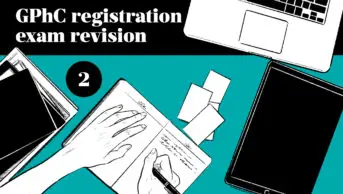
Wes Mountain/The Pharmaceutical Journal
By the end of this article, you should be able to:
- Understand the components of the General Pharmaceutical Council’s assessment framework;
- Use the outcomes and indicative assessment topics to organise your revision;
- Understand the structure of the exam and how to plan your preparation time;
- Know the main topics for part 1 and part 2 of the exam;
- Know what resources you can access to support your revision.
Introduction
In the run up to the General Pharmaceutical Council (GPhC) registration assessment, it is common for foundation trainees to feel overwhelmed by the scale of content that must be covered, but with good preparation, you can effectively take control and improve your chances of success. This article outlines six steps that can break the task down into manageable stages, using the various components of the GPhC registration assessment framework as your guide. It will also walk you through example questions, showing how the assessment framework can be applied to pharmacy practice, and provide tips and advice on the ‘single best answer’ question format used in the exam.
This article is the first of a three-part series for foundation trainees preparing for GPhC registration assessment. In parts two and three, we will look at specific sections of the framework in closer detail and work through more example exam questions.
Step 1: Download, read and understand the GPhC assessment framework
If you have not done so already, your first step should be to download a copy of the GPhC assessment framework and work through the online sample questions[1]. It will also be helpful to have it to hand as you read through this article.
The GPhC exam consists of two papers: part 1, which focuses on calculations, and part 2, which covers everything else. The GPhC registration assessment framework contains all of the learning outcomes tested by the registration assessment. It is organised into two knowledge themes:
- Expectations of pharmacy professionals: This focuses on principles of clinical governance, a duty of care about a colleague’s health, performance or conduct that may be detrimental to the public, responding to medical emergencies, and how pharmaceutical sciences are used to develop medicines and medical devices.
- The skills required in practice: This theme represents the bulk of the assessment framework and focuses on practical knowledge, theory and skills. It is further divided into five subtopics:
- 10.2.1 Implementing health policy;
- 10.2.2 Validating therapeutic approaches and supplying prescribed and over-the-counter medicines;
- 10.2.3 Ensuring that safe and effective systems are in place to manage the risk inherent in the practice of pharmacy and the delivery of pharmaceutical services;
- 10.2.4 Working with patients and the public;
- 10.2.5 Maintaining and improving professional performance.
Step 2: Use the outcome weightings and indicative assessment topics when planning your revision
Individual outcomes have different relative importance and are weighted as low (up to 10% of questions), medium (25–35% of questions) or high (60–70% of questions). Use the weightings to allocate your time wisely but don’t neglect the low and medium weighted outcomes. Marks gained in the low weighted topics could make a significant difference to the final score and it is vital that future pharmacists have a broad knowledge base to draw from when entering practice.
Revision tip: work out which sections of the framework will need the most time
Make sure you give sufficient time and focus to section 10.2.2 in the ‘skills required in practice’ knowledge theme. It contains eight learning outcomes, seven of which carry a ‘high’ weighting.
Each outcome is then supported by indicative assessment topics, which illustrate how examiners may apply the outcome to pharmacy practice. They are intended to help you better understand the learning outcome but it is important to note the word indicative here — don’t be thrown off if the question set in the exam is different to what you were expecting.
Step 3: Prepare adequately for calculations questions
It is important to highlight the third outcome in section 10.2.3 ‘Use pharmaceutical calculations to verify the safety of doses and administration rates’. Pharmaceutical calculations form part 1 of the GPhC exam paper and the topics are highlighted in the box below.
Box 1: Topics for part 1 of the GPhC registration exam (calculation paper)
- Doses and dose regimens;
- Dosage and unit conversions;
- Estimations of kidney function;
- Displacement volumes and values;
- Concentrations (e.g. expressed as w/v, % or 1 in x);
- Dilutions;
- Molecular weight;
- Using provided formulae;
- Infusion rates;
- Pharmacokinetics;
- Health economics;
- Quantities to supply.
It is vital to practice samples of these questions from the GPhC website so that you are familiar with the format and the online platform you will be using on the day. The calculations paper is not the focus of this series, but a range of useful resources from the Royal Pharmaceutical Society, The Pharmaceutical Journal and other organisations and training providers are listed at the end of this article.
Revision tip: remember the real-world context behind calculations questions
Remember to consider the underlying practicalities for any question involving calculations. For example, when asked to calculate a quantity to supply, you will most likely need to work out the amount of product required, while also factoring in pack quantities, size, space and storage considerations. Examiners are not looking to assess your ability as a mathematician, they are looking for you to demonstrate that you are able to perform suitable calculations accurately, and holistically apply your answer to pharmacy practice.
Step 4: Create a plan for covering all therapeutic areas
In addition to the 2 knowledge themes, there are 15 therapeutic areas specified in the framework, again with weightings of high, medium or low, indicating the proportion of questions that they will account for in the exam. All questions that relate to clinical care are mapped to these therapeutic areas. An individual question may map to multiple therapeutic areas; for example, a patient may be described as having both hypertension and type 2 diabetes.
While some knowledge can be applied in a generic way to all therapeutic areas, others will require specific study. For example, when applying pharmaceutical knowledge to medicine formulations, you will need to understand how this differs between medicines used for cardiovascular disease compared with gastrointestinal problems. This requires you to process and absorb a large amount of information, but with adequate planning, it is possible to cover a lot of ground in the time available to you. Part 3 in this series looks at how to revise the therapeutic areas in more detail.
Revision tip: consider your areas of strength and weakness
Everyone has topics they find harder to master than others. There may also be therapeutic areas that you have particularly enjoyed learning about or have a strong interest in. Make sure to reflect on this as you start planning your revision and access a wide range of sample questions to identify knowledge gaps or areas of weakness. From here, you can devote more time to the subjects you find hardest.
Step 5: Create a revision timetable
You should now create a weekly revision schedule (and stick to it!) to help you maximise the time available. The Figure provides an example of what this might look like.
Step 6: Think about the question formats used in the exam
It is also important to consider the format of questions that you will face in part 2 of the registration exam, which are single best answer (SBA) and extended matching questions (EMQs)[1].
SBA questions test the candidates’ ability to apply knowledge and come up with a single answer that stands out above the other answer options. This is very differnet to questions designed to test knowledge recall of isolated facts[2]. All five answer options given for a scenario are likely to be correct in some way; however, one of the answers will stand out above the rest as the ‘best’ answer.
Another feature of SBA questions is that they should obey the ‘cover options’ rule, meaning that it should be possible for the candidate to be able to answer the question correctly even if the answer options were ‘covered’[2]. If you find yourself struggling to figure out the SBA from the five answer options, it may be that you have not understood the nuance within the scenario well enough, or you have not sufficiently prepared for the topic. To illustrate this, two worked examples are provided below showing a representative SBA question and how you might work through the options to identify the best answer.
Example question 1
Framework reference number 10.2.2, fifth outcome; indicative assessment topic: drug interactions
You have received a discharge advice letter for A. Jones, a white British male aged 60 years, who was discharged from hospital five weeks ago after suffering acute coronary syndrome, determined on ECG as ST elevation myocardial infarction. He has a longstanding history of high blood pressure, constipation, anxiety and depression, which is being managed by:
- Amlodipine 10mg tablets 1OD,
- Sertraline 100mg tablets 1OD,
- Senna 7.5mg tablets 2 nocte prn
His new medicines on discharge and their current doses are as follows:
- Aspirin 75mg tablets 1OD,
- Clopidogrel 75mg tablets 1OD,
- Simvastatin 20mg tablets 1OD,
- Ramipril 10mg capsules 1OD,
- Bisoprolol 10mg tablets 1OD.
It has now been five weeks post discharge and Mr Jones informs you that he has noticed tarry stools.
What drug(s) would you most attribute to drug interactions that lead to tarry stools?
A. Aspirin + clopidogrel only
B. Aspirin + ramipril + simvastatin
C. Clopidogrel + ramipril + simvastatin
D. Aspirin + clopidogrel + sertraline
E. Aspirin + senna + sertraline
Discussion:
As described earlier, single best answer questions test multiple knowledge sets and their applications to a given scenario, and are designed to test higher order thinking. The knowledge sets tested here include knowledge of signs and symptoms suggestive of various anomalies and, in this case, gastrointestinal (GI) bleeding.
A competent examiner would never include that Mr Jones has GI bleeding in the scenario, as the candidate should be able to understand that the non-steroidal anti-inflammatory drugs (NSAIDs) or antiplatelets are the culprits in the first instance. It is therefore essential to know that a sign of lower GI bleeding is tarry stools, which indicate digested blood. The additional knowledge being assessed is around side effects, so the candidate must know which group of drugs are associated with GI bleeding and how that manifests in the patient. For Mr Jones, it is tarry stools.
In the case of upper GI bleeding, the patient would have presented with vomiting coffee-ground material and the implicated drugs would be the same as above. In this scenario, aspirin and clopidogrel are obvious giveaways, but other drugs in the same class (e.g. prasugrel, ticagrelor or dipyridamole) could have been included in the scenario; for this reason, it is important that you have knowledge of several examples from each drug class and do not assume that the question will use the most common medicine.
The other prerequisite knowledge is around drug interactions, but before you move on to this, you should put everything into context and quickly scan which drugs can be associated with a GI bleed. Antiplatelets, anticoagulants, NSAIDs and corticosteroids are associated with GI bleeding, so you should check if drug(s) in one of these classes are prescribed. In this scenario, the patient is taking two antiplatelets — aspirin and clopidogrel — so he is at high risk of GI bleeding.
Next, think of the interactions of antiplatelets with various drug classes, focusing on increased risk of GI bleeding. According to the British National Formulary and the National Institute for Health and Care Excellence, there is increased risk of bleeding if antiplatelets are combined with other drugs that also increase the risk of bleeding (e.g. other antiplatelets, corticosteroids, NSAIDs, oral and parenteral anticoagulants, selective serotonin re-uptake inhibitors [SSRIs] and serotonin and noradrenaline re-uptake inhibitors)[3,4].
Looking at the scenario again and applying the above, the interacting drugs and cause of GI bleeding for Mr Jones would be aspirin (antiplatelet), clopidogrel (antiplatelet) and sertraline (an SSRI). Although A, B, C and E are partly correct (owing to presence of an antiplatelet), they do not stand out as the single best answer, thus leaving D as the best answer.
Correct answer: D
Next, let us focus on extended matching questions (EMQs). According to Swanson and Case [4], when creating EMQs, the examiner will decide a theme, the answer options, and the lead in, and then the items are constructed, which you are required to match with one of the answer options (these can be used for several items)[2]. Examples of EMQs are shown below — both questions are based on the same list of options, but different scenarios.
Example question 2
The next two questions are based on the same list of options, but different scenarios.
Each option may be used once, more than once or not at all.
A. 12 years and over
B. 12 years to 18 years
C. 15 years to 50 years
D. 16 years and over
E. 16 years to 60 years
F. 18 years to 45 years
G. 18 years to 65 years
H. 45 years to 75 years
Question 2a
A patient presents at the pharmacy to purchase sumatriptan 50mg tablets.
Select the most appropriate age for the sale to be legal.
Discussion:
This question requires knowledge of the licensing requirements of over-the-counter (OTC) sumatriptan 50mg — this information can be found in the summary of product characteristics (SmPC) via the Electronic Medicines Compendium. Foundation trainees should be mindful to study the OTC version of sumatriptan as there is slight variations in the information contained in the OTC and prescription-only versions. The correct answer according to the SmPC is 18 years to 65 years.
Correct answer: G
Question 2b
A patient presents at the pharmacy to purchase naproxen 250mg tablets for period pain.
Select the most appropriate age for the sale to be legal.
Discussion:
This question requires knowledge of the licensing requirements of over-the-counter naproxen 250mg for period pain. This information can be found in the summary of product characteristics (SmPC) via the Electronic Medicines Compendium. The correct answer according to the SmPC is 15 years to 50 years.
Correct answer: C
Summary
This first article in the series has explored the GPhC framework and highlighted how to use the learning outcomes and indicative assessment topics to guide revision. It has also highlighted how weightings can be used to help allocate time strategically, but remember that you will gain a higher chance of success if you begin your revision early enough to allow all sections of the framework to be covered adequately. We have also highlighted the need to cover all 15 therapeutic areas and provided some advice on how to approach single best answer questions in the exam itself.
Useful revision resources
- Medication maths: how to solve dose and dosage calculations
- Medication maths: how to solve infusion calculations
- Medication maths: quantities to supply and provided formulae calculations
- Medication maths: how to solve pharmacy calculations — concentrations, dilutions and health economics
- Your pharmacy calculations prep guide
- OnTrack
- Medicines Ethics and Practice
- RPS library
- British National Formulary
- British National Formulary for Children
- Focus preregistration revision
Disclaimer
The views in this article are those of the authors and do not represent the views of any organisations they are associated with. The questions and explanations presented here are for educational purposes only and do not replace your training, knowledge and application of professional judgement as a pharmacist or trainee pharmacist. The example questions used in this article and the answers provided are for educational purposes and should not be translated to represent what would happen in real practice.
Acknowledgements:
All practice questions were reproduced with kind permission provided by Focus Pre-Reg Revision
RPS revision course with mock assessment
This course is designed for all foundation trainees sitting their General Pharmaceutical Council (GPhC) registration assessment in summer or autumn 2025.
Available exclusively to foundation trainee RPS members as part of their membership, revision webinars start in March 2025 and booking is now open for trainees to secure their place.
- 1Registration assessment framework. General pharmaceutical council. 2024. https://www.pharmacyregulation.org/53-registration-assessment-framework (accessed April 2024)
- 2Case S, Swanson D. Constructing Written Test Questions For the Basic and Clinical Sciences. Research Gate. 1998. https://www.researchgate.net/publication/242759434_Constructing_Written_Test_Questions_For_the_Basic_and_Clinical_Sciences (accessed April 2024)
- 3Antiplatelet drugs. British National Formulary. 2024. https://bnf.nice.org.uk/treatment-summaries/antiplatelet-drugs/#:~:text=Use%20of%20clopidogrel%20with%20aspirin,of%20a%20proton%20pump%20inhibitor (accessed April 2024)
- 4Antiplatelet treatment. National Institute for Health and Care Excellence. 2023. https://cks.nice.org.uk/topics/antiplatelet-treatment/ (accessed April 2024)
You might also be interested in…

Hospital pharmacist trainees more likely to pass registration exam than community trainees, finds analysis

Preparing for the GPhC registration exams: how to revise learning outcomes relating to clinical knowledge and therapeutic approaches

